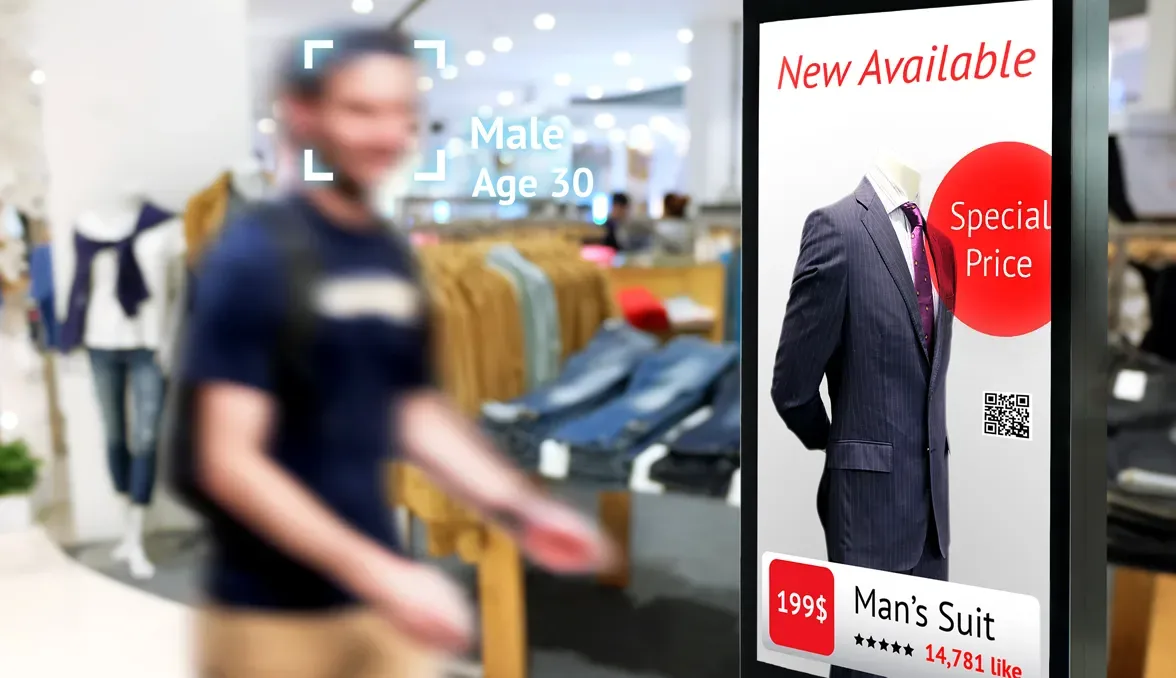Artificial Intelligence (AI) and the Internet of Things (IoT) have revolutionized multiple industries in recent years, and Digital Signage is no exception. The adoption of these innovative technologies is opening new horizons in the world of digital signage software, offering interactive and engaging experiences that go beyond the simple display of static content.
AI in Digital Signage
Thanks to AI, digital signage software can analyze real-time demographics, customer behavior and user preferences to deliver highly personalized content. AI engines learn from interaction patterns and automatically adjust content based on audience characteristics. This allows you to offer targeted and relevant messages, increasing engagement and maximizing the impact of communication campaigns.
The IoT in Digital Signage
The IoT allows devices and sensors to connect to digital signage software, creating an intelligent network where devices can communicate with each other and with the outside world. This allows you to monitor and control devices remotely, providing real-time information on screen status, environmental conditions and user interactions.
The IoT also allows for the creation of interactive experiences, allowing users to interact with content via mobile devices or proximity sensors.
The Benefits of AI and IoT in Digital Signage
The adoption of AI and IoT in digital signage software offers many benefits.
AI-powered solutions allow you to create personalized experiences, improving audience engagement and generating measurable results.
The IoT allows centralized and intelligent management of devices, reducing maintenance times and allowing immediate reaction in case of problems.
Furthermore, AI and IoT enable detailed data collection, offering valuable insights to optimize marketing strategies and improve the overall customer experience.
Towards an Innovative Future
The adoption of AI and IoT in digital signage software represents a milestone in the evolution of this technology.
Predictive capabilities, intelligent interaction, and content optimization enable businesses to deliver engaging and tailored experiences for their audiences.
The future of Digital Signage is here, ready to surprise and amaze with increasingly intelligent and effective solutions.
Here’s how these trends will affect the future of digital signage:
- Artificial Intelligence: The integration of artificial intelligence into digital signage will allow for greater personalization and interaction with the audience. AI can analyze demographics, user behavior and preferences to deliver highly personalized content in real time. Additionally, AI can power facial recognition, speech recognition, and emotion analysis capabilities to create even more targeted and focused experiences.
- Internet of Things (IoT): Connecting Digital Signage screens to the IoT opens up new possibilities for interaction and monitoring. IoT devices can collect environmental data, such as temperature, humidity or human presence, to adapt content based on context. Additionally, IoT enables centralized management of a network of displays across multiple locations or locations, making it easier to distribute content and monitor performance.
- Interactive displays: Interactive displays allow audiences to interact directly with content. This technology provides opportunities to actively engage users by allowing them to tap, select options or even use gestures to control content. Interactive displays can be used for presentations, product experiences, interactive maps and more, enhancing audience engagement and participation.
- Advanced Data Analytics: As AI evolves, so will more sophisticated analytics tools for Digital Signage. Advanced data analytics will allow you to gain insights into user behavior, preferences and emerging trends. This will enable data-driven decisions to optimize content, improve campaign effectiveness, and anticipate audience needs.
- Augmented Reality and Virtual Reality: Combining Digital Signage with Augmented Reality (AR) and Virtual Reality (VR) will create engaging and immersive experiences. Screens can act as a bridge between the physical and digital worlds, allowing audiences to interact with virtual objects or experience virtual environments through devices such as AR glasses or VR headsets.
- Location-based personalization: Thanks to geolocation technology, Digital Signage content can be personalized based on the user’s location. For example, as a person approaches a screen, content can be tailored to provide specific location information, local promotions, or directions to certain points of interest.
These trends point to a growing interaction between advanced technologies and digital signage, enabling businesses to deliver more engaging and personalized experiences to audiences.
Harnessing the power of AI, IoT, interactive displays and other emerging technologies will enable companies to differentiate, engage audiences and achieve meaningful results from their Digital Signage campaigns.
Are there any risks from introducing AI into digital signage?
While Artificial Intelligence (AI) offers numerous benefits in the field of Digital Signage, it is important to recognize that there are also some risks associated with the introduction of this technology. Here are some points to consider:
- Data privacy and security: The use of AI in Digital Signage requires the collection and processing of a vast amount of data, including personal data such as user preferences and behavior. It is essential to guarantee the privacy and security of this data, protecting it from unauthorized access or improper use. Compliance with data protection regulations, such as the GDPR, is an essential aspect to consider.
- Bias and Discrimination: AI can be affected by biases or biases present in training data, leading to decisions or content that may be discriminatory or unfair. Steps need to be taken to mitigate these risks, such as using diverse datasets and implementing algorithms that minimize the risk of discrimination.
- Reliability and Control: AI can be prone to errors or misinterpretation of information. It is important to closely monitor the performance of the AI and to intervene promptly in case of anomalies or unwanted results. Maintaining control over the system is critical to ensuring content is accurate and appropriate.
- Technology Dependency: Integrating AI into Digital Signage requires a strong technology infrastructure and specialized skills. This can lead to greater reliance on technology and more complexity in managing the system. It is important to carefully evaluate the resources needed to implement and maintain AI in digital signage.
- Public Acceptance: The introduction of AI in Digital Signage may be received differently by the public. Some users may be concerned about the collection and use of their personal data, while others may have reservations about interacting with AI-powered systems. Communicating transparently and educating the public about the responsible and safe use of AI can help mitigate these concerns.
Conclusion
AI in Digital Signage offers many benefits, but it is crucial to address the related risks responsibly.
With careful planning, careful management of data and constant vigilance, it is possible to reap the full benefits of AI while protecting the rights and privacy of users.




